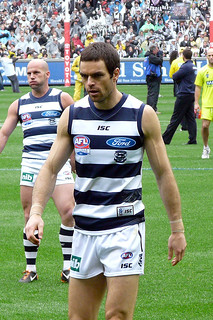And as Scarlett ambles into the Torquay half-light, the accompanying sound you hear is the death rattle of greatest era in Geelong Football Club's history. Any player in the 2007 and 2009 Premiership sides was replaceable, bar him. In fact, when the Cats won the 2011 flag to make it their third in five, many of the original entertainers had already been superseded: Cam Mooney, Darren Milburn, Tom Harley. Even Little Gary. The only legatees of a team that was both truly great and startlingly deep are James Bartel, Joel Selwood, Corey Enright and - for another year, anyway - Paul Chapman.
Scarlett the Younger came to the Cats in the 1997 draft. I had the pleasure of witnessing his first game, in the last round of 1998, where he played Matthew Lloyd straight up. He was overmatched by the spearhead ascendant, but fought gamely and was rarely - if ever - beaten by the Lloyd again. By 2000, Scarlett was integral, the ultimate answer to Geelong's perpetual full-back problem.
 |
| flickr.com/photos/jamesdphotography |
It was this ability to produce wave after wave of attack while not sacrificing positional defence that made Scarlett the best full-back of all time. No full-back has combined attack and defence so perfectly. He was precise in disposal, had the ability to gut-run and understood when to do so and the bodily strength to wrangle down opposing power forwards. He was also clutch. Ask Buddy Franklin, who from 2008 to 2011 dominated Geelong defenders - until it was Scarlett's turn to stand him.
Or ask St. Kilda.
For over a hundred years, full-backs were nothing but stoppers. The player selected in that position in the AFL's Team of the Century in 1996, Steven Silvagni, could barely kick forty metres. Let alone run, bounce and deliver a pinpoint pass. The position changed because of Scarlett and his contemporary Dustin Fletcher - full-backs are now so much more than taggers who stand next to the goals. Although their methods differed - and, obviously, my preference was Scarlett's - the influence they exerted across the entire ground rather than just within 35 metres of the goals, make them the best the game has seen.
No-one can replicate what Matthew Scarlett has done for his club, nor could they redefine the position the way he did. He was the ultimate full-back.

No comments:
Post a Comment